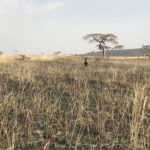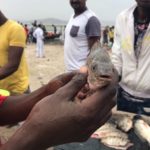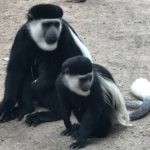3-4 February 2018
Today I ride in the last car of a five car caravan. This is important.
This morning we retrace our journey north following Highway 9 to Sodo and 41 to Alaba Qulito leading up the Rift Valley toward Addis Ababa. We pass fertile farmland planted with bananas, grains and tobacco. The savannah is quite beautiful. The soil is rich and dark; food and cash crops are in abundance. Various fruits, from huge mangos and avocados to small pineapples, are sold along the roadside. Almost the entire road is paved. But the real show is the road traffic and its sideshows.
 The traffic of donkey carts has increased considerably. Much foot traffic uses the road. Large herds of goats, cattle and donkeys abound. Even a large herd of camels compete for space. It is not the sharing of this two lane road that is noteworthy, but that we skim past it all at 40-50 mph. We slide between two steers, clearing each horn by inches. Matadors couldn’t do better. Goat standing in the middle of the road bleating for mama? Zip past and please goat, don’t turn around or change direction. Donkey carts and tuk tuks are smaller than us so “honk” and we are passing. Three lanes of cars, donkey cart and livestock vying for a narrow two lane road. One rarely drives in one’s own lane of the road. Bigger than our Land Cruiser? We will concede the lane to you. Otherwise, “honk” out of the way. The front seat is up close and personal with narrow scrapes with death.
The traffic of donkey carts has increased considerably. Much foot traffic uses the road. Large herds of goats, cattle and donkeys abound. Even a large herd of camels compete for space. It is not the sharing of this two lane road that is noteworthy, but that we skim past it all at 40-50 mph. We slide between two steers, clearing each horn by inches. Matadors couldn’t do better. Goat standing in the middle of the road bleating for mama? Zip past and please goat, don’t turn around or change direction. Donkey carts and tuk tuks are smaller than us so “honk” and we are passing. Three lanes of cars, donkey cart and livestock vying for a narrow two lane road. One rarely drives in one’s own lane of the road. Bigger than our Land Cruiser? We will concede the lane to you. Otherwise, “honk” out of the way. The front seat is up close and personal with narrow scrapes with death.
We exit the paved road for a dirt one lane path to a wildlife sanctuary. The road is dusty, narrow and rutted. We bounce and swerve, looking for the easiest path. Kids appear out of the dust like magical imps and waifs. They wave, they jump and yell, they dash for the cars. They attack. Some have rocks in their hands ready to throw. It appears there is a game here called “who is the dumbest of them all?” Children as young as three dash for the side of the road and see how close they can come to touching the mighty Toyota as it charges past. Do we clear these kids by more than two inches? I am not sure. We are squeezed on both sides by masses of children all younger than eight. Older ones run over and buried already?
Being the fifth car to pass, the children are all waiting for their opportunity to play stupid.

 Stop and the swarms are like “the children of the corn.” We are surrounded by small kids who must learn begging at their mother’s breast. They beg for “pen,” or “money” or food. They pantomime “shirt” as if I am going to strip and give them the shirt off my back. They just beg for begging’s sake.
Stop and the swarms are like “the children of the corn.” We are surrounded by small kids who must learn begging at their mother’s breast. They beg for “pen,” or “money” or food. They pantomime “shirt” as if I am going to strip and give them the shirt off my back. They just beg for begging’s sake.
These are not starving children. We see few children that look hungry and none that are homeless. Clothing sometimes is iffy but all mothers would find it difficult to keep their children clean in this dusty environment. Well-dressed children, obviously well-taken-care-of children beg for something. And a few, getting a firm “no” will just cock their head to look cute and coy, hoping it will change one’s mind. Do they have a kindergarten that trains them? “Tap, tap, tap tap” forever on the windows to gain your attention to ask for something. Anything. Their sharp eyes scan the inside of the cars, your clothes, what is in your hands, any bulging pocket. “You must have something to give me” their faces say. We are told firmly, “do not give the children anything.” No problem, for after days and days of this, I can’t imagine doing so.

Swayne’s Hartebeest
The Shenkele Wildlife Sanctuary was established to protect the endangered species of the Swayne’s Hartebeest and covers a small area of 20 sq. miles. There are also other mammals in the sanctuary and 91 species of birds. This reserve is protecting one of the last areas of original Ethiopian savannah. I can see some farming of the vast expanses of grain and burning of the fields for regrowth.
What I don’t see are a lot of animals. There are a few distant hartebeests, both small light-beige females and beautiful horned males. Swayne’s Hartebeest is a species of antelope and one of the rarest animals in of all Africa. Its population numbers less than 700. We probably saw thirty at a distance.
We traverse the gauntlet of kids to reach the safety of cattle, cycles, donkey carts and speeding trucks. Driving again through the Rastafarian town of Shashemene, we quickly reach our own sanctuary of Haile Resort in beautiful downtown Hawassa. Situated at 6119 ft. and sitting on the northeast shore of Lake Awasa, it is indeed our refuge for the next two nights.
Sunday morning is chilly. After over 95° in the south, this is heaven. The lake, placid yesterday, is churned by strong morning winds. If morning church services didn’t wake us, the big road machinery outside did.

Nile Tilapia
We explore the famous fish market of Asa Gebeya located on an inlet to Lake Awassa. Every morning, fisherman arrive by their wooden row boats loaded with their daily catch of tilapia, catfish, and golden fish. The setting is frenetic with the buying, selling, flaying and cooking of the fish. In just a few steps you can purchase your tilapia, have it cleaned and flayed, buy your lime or very hot red chili sauce, have it cooked or raw, buy some bread and sit under a tree to eat amongst family and friends.

All of this is observed by possibly the ugliest bird on the planet. The Marabou Stork is a large wading bird in the stork family and generally lives south of the Sahara, in both wet and arid habitats, especially near garbage dumps. In the fish market, it is easy pickings of fish guts. Some walk around with large filled gullets, waiting for an opportunity to stuff one more bite down for the day.
We also take a pleasant walk around Amorra Gedel Park just west of the fish market and home to a plethora of vervet and colobus monkeys among the huge fig and ficus trees. The black-and-white colobuses are Old World monkeys and native to Africa. Their long tail ends in a distinctive white puff. Neither variety of monkey is disturbed by our presence and will get very close as they walk about, climb trees, or attempt to jump on your shoulders for a handout. The vervet babies cling to the belly of mama vervet for protection, yet they watch me as curiously as I watch them.
 Lake Awassa, the smallest of the Rift Valley lakes, is about 35 sq. miles and surrounded by rolling hills, formed in an ancient volcanic crater. The shoreline is active with birdlife. I hear there might be a hippo hanging out somewhere, and a few endemic birds call it home. My tendency for seasickness tells me that I would rather return to my patio, have a good Ethiopian beer, and relax on this, my last day in the south.
Lake Awassa, the smallest of the Rift Valley lakes, is about 35 sq. miles and surrounded by rolling hills, formed in an ancient volcanic crater. The shoreline is active with birdlife. I hear there might be a hippo hanging out somewhere, and a few endemic birds call it home. My tendency for seasickness tells me that I would rather return to my patio, have a good Ethiopian beer, and relax on this, my last day in the south.
Tomorrow, I return to Addis and my flight home. I think I am ready.




0 Comments